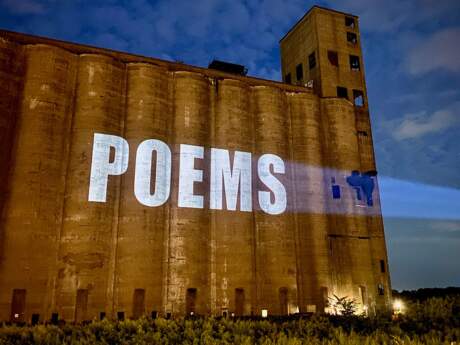Interviews
An Interview with Jamie Falkowski and Ethan Weinstock of The Newstand
In the middle of June, ALLDAYEVERYDAY, a creative agency, began renting a vacant newsstand at the Metropolitan Avenue subway station in Williamsburg Brooklyn. Since then, The Newsstand has served as an unconventional retail space for the writing and art of many independent, local artists as well as some larger publishers. In addition to its focus on small press publishing, The Newsstand carries music, tote bags, postcards, and, of course, snacks. I spoke with Jamie Falkowski, head of marketing and strategy for ALLDAY, and Ethan Weinstock, a cashier and project manager at The Newsstand, about The Newsstand's evolution and its unique location at the intersection of commuter travel and the art and publishing worlds.
What is ALLDAYEVERYDAY?
ALLDAYEVERYDAY is divided into two distinct divisions: Original Programming and Creative Services. Our original programming generates content and experiences in partnership with writers, artists, filmmakers and photographers, giving them a platform for exposure and collaboration. Our creative services division provides tailored digital, creative, entertainment and content executions for clients including Nike, Standard Hotels, Club Monaco, Express, Land Rover and others.
How does The Newsstand fit in?
Kevin and I both live near by, we were coming back from the office one day, and I pointed it out the empty newsstand and mentioned that in another life I would love to do something with that space. We laughed about it, but kept discussing it further. And at the time we were looking for ways to increase ALLDAY's original programming and involve a larger audience.
When we thought about using the space to offer independent zines, Lele Saveri came to mind. We had helped with PR and production for the last 8-Ball Zine Fair, and he has been a friend of Kevin's and ALLDAY's for a long time. We thought he was the perfect person to come in and curate the space, as well as broaden the relationships with some of the bookstores, like Dashwood and McNally Jackson. Since then, the space has been this ever-evolving platform for artists. We initial thought of The Newstand as temporary, but we've been discussing the possibility of being able to keep it open longer.
The most rewarding part of opening the space has been seeing all the self-published work that comes in; almost every day a maker or an artist comes to drop off a zine or wants to be featured in the space. The books aren't coming from individuals, though. Most of the books are coming from Karma, which is a bookstore and a lot of what they sell is out of print or harder to find titles. All the music is curated by Co-Op 87, a record store in Greenpoint that hauled in new and independent artists as well as a really nice selection of out of print vintage vinyl. I was surprised to see how well the vinyl has been received—people really seem to like being able to grab something like that out of context, on the subway. We're also launching a mixtape series over the next week and original cassettes done up by different artists.
Of course, there are some other off-kilter items in here. How are, say, the snacks selling?
Surprisingly well. Part of the idea in creating a space like this was to offer value to the everyday commuter as well as to the artist community. We've curated a number of local snacks, and picked up a few things that some people have asked for like gum or candy. We also carry Perrier, who were kind enough to donate their product, and Kombucha.
How many volumes do you have in the stand at the moment?
Jamie: I'd say there are over 150 individual titles.
Ethan: No, its more than 200 individual artist titles, and each publisher gave us two titles each.
Jamie: So there are probably around 250/260. We started with the 100 or so titles from the publishers we wanted to work with. Lele has curated the 8-Ball Zine Fair for the last three seasons, so he has these relationships with, say, Ed Varie or Dashwood. We worked with them and made an initial selection of books. We also reached out to a handful of people in the zine world, just giving them a heads up. Within the first weekend, we had people coming in to the store wanting to drop off their work.
Along with all of artists, who are the customers of The Newsstand?
Jamie: We serve different kinds of people: there's the person who comes in and really knows about zines and the zine culture and is really excited that a place like this exists, knows some of the titles, has a friend whose book is the space, or even made one of the books themselves; then there is the commuter audience, the person that is rushing between the G and the L on their way to work, and they may give the store a double-take the first time they see the space, but more often than not, we see a lot of those people mentally note it and then come back to spend more time. It is really great to serve an already existing art community, but it does give something unique to serve the daily subway commuter.
Ethan: It's also a community for artists who create this type of work—they are meeting each other here all the time. Someone will come in and drop something off, somebody will grab it off the shelf as soon as they've made it, and they will get a chance right there to talk abut their work.
Jamie: Yeah, we sell a lot of things the same day they arrive. There's a large returning clientele for some of the bigger name artists, but it's also nice to get to celebrate some of these individuals and showcase a really wide range of different types of material.
The press that the stand has received seems largely to pigeonhole the stand and claim that it's offbeat for its own sake. Has that made an impact on the public perception of the stand?
I don't think that it has really affected the way people come in here. There's sort of two parts to the press coverage. First, it's probably good for S.E.O. to have the word hipster in a headline about us. It's also just the easiest headline, the easiest way to characterize something you don't know about. We knew that was going to happen when we opened the space. It's good just to get a lot of people talking about it, but of course it's unfortunate that most people are seeing it through that one lens. Really, anything you do in Williamsburg has the potential to be characterized in that way, but this is a great audience for what we are trying to do, and we couldn't have picked a better subway station for the amount of traffic and type of consumer it attracts. You never know who's going to come in and ask for what, and even after rush-hour, we have people that are swiping back in to the station just to come check out what's down here.
* * *
The Newstand will be open until August 31, 2013.


